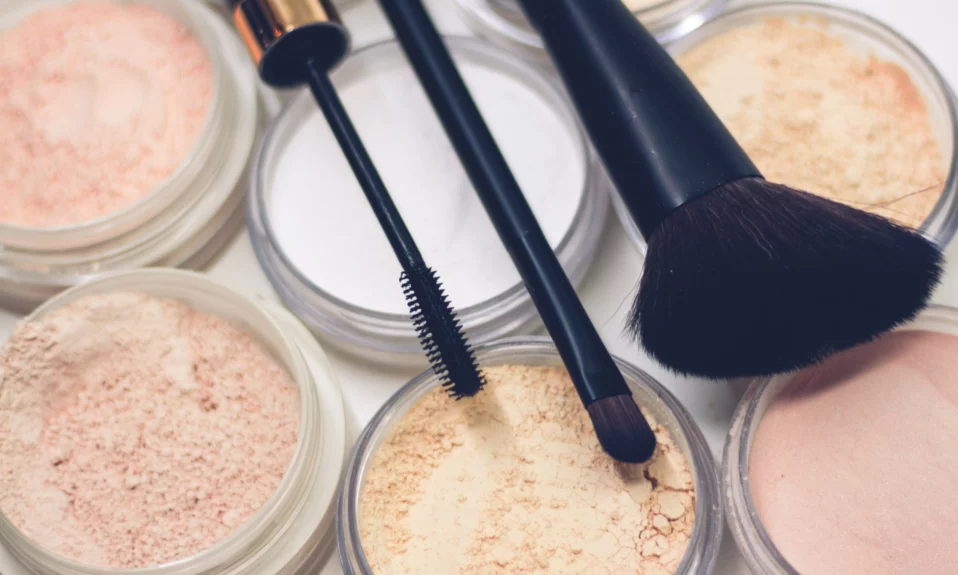
Have you ever painted with watercolors? Watercolors are different from other painting tools. Almost no tool can match its brilliance and freshness. Because watercolor has lively colors and at the same time delicate with high transparency.
In addition, the almost quick drying of watercolors makes it a suitable option in contrast to acrylic and oil paints. This is why this tool is so popular. Today we are going to get to know this painting tool better. If you want to get started with it, let me help you. Let’s go:
- What is watercolor?
- Where is the origin of watercolor?
- How to make watercolor?
- What do you need to do to paint with watercolors?
- What are the different watercolor techniques?
- What are the common mistakes in watercolor?
- What is the best watercolor paper?
- What is the best watercolor brush?
- How to mix the colors of the watercolor?
- Color palette inspiration of watercolor paintings
- Last words
What is watercolor?
Watercolor is one of the drawing tools as well as a design to draw using this tool. In fact, this colored substance consists of a combination of pigment and a sticky substance that dissolves in water. For this reason, it is different from many painting tools, especially the color of coating materials.
There are no dangerous solvents associated with watercolors and it is also easy to wash with soap and water. In addition, in watercolors, light shades are created by diluting the paint with water, not by adding white paint like oil paints!
Types of watercolors:
In general, there are three types of watercolors:
- Transparent watercolors
- Matte watercolors (gouache)
- Liquid watercolors

Where is the origin of watercolor?
Watercolor paintings have a long history. The paintings of the Paleolithic era of Europe can be considered the first attempt to use watercolors. But the first artist known to use watercolor is Albrecht Dürer.
Dürer is a Northern German Renaissance artist. Several watercolor paintings of landscape, wildlife and botany remain from him. In addition, watercolors were also used by Baroque painters. So little by little the use of this painting tool became widespread.
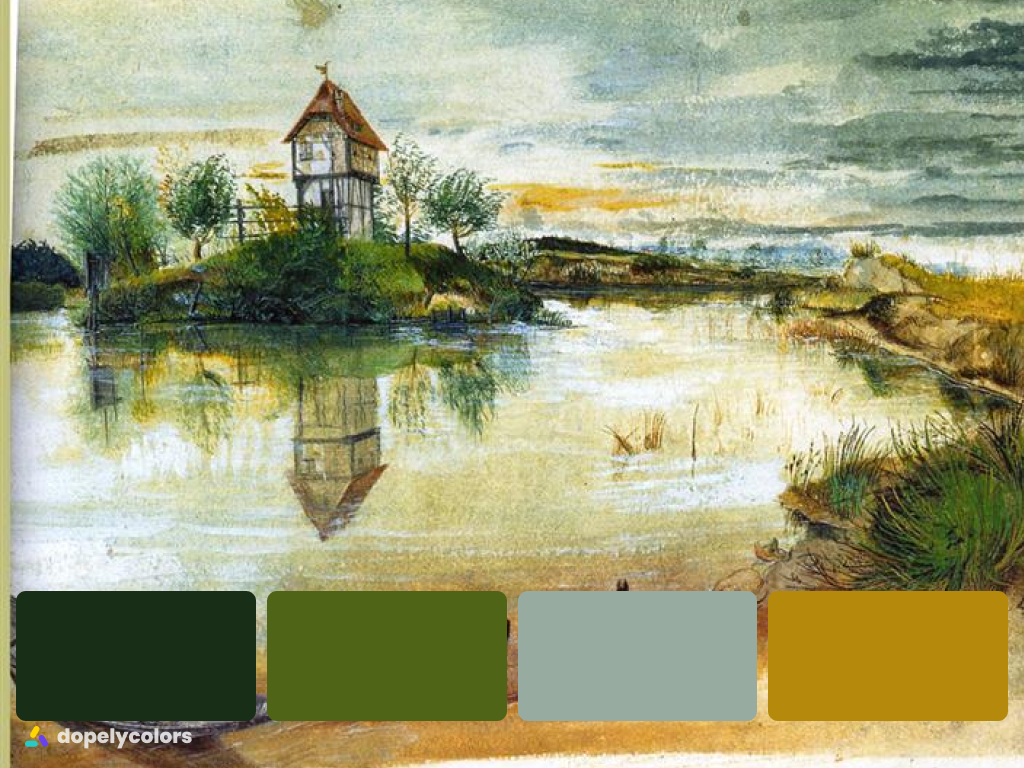
How to make watercolor?
As I said before, watercolor is created by combining different pigments with a glue. Usually, this glue is made from the combination of gum arabic, distilled water and some other additives that are needed to preserve the color.
However, each watercolor manufacturer has their own method of producing it. For this reason, different methods cause different quality and compatibility of watercolors. To have a handmade watercolor, you can combine pigments with honey instead of gum Arabic. And to soften the mixture, add glycerin to it.
What do you need to do to paint with watercolors?
One. First, you need to prepare what you need to start painting with watercolors. You will need water, watercolor paints, special brushes, watercolor paper, pencils to draw the initial design, towel to dry the brushes, sponge, board and tape.
Two. In the second step, you need to set up the watercolor painting workspace for yourself. Create a space for your work that can accommodate your materials. So that it allows you, for example, to place your water in a place where it will not accidentally spill on your work. Also, if you don’t want to use the board, place a towel or newspaper to protect the surfaces below your work.
Three. Use a color wheel or color reference. This will increase your skill in mixing colors and choosing the right color for your work.
Four. Try ways to warm up and get started with the paintbrush. Also use watercolor techniques to create your best work.
Five. If you don’t have a basic design to draw, you can use pre-drawn designs that are available on the internet, print them and start coloring.
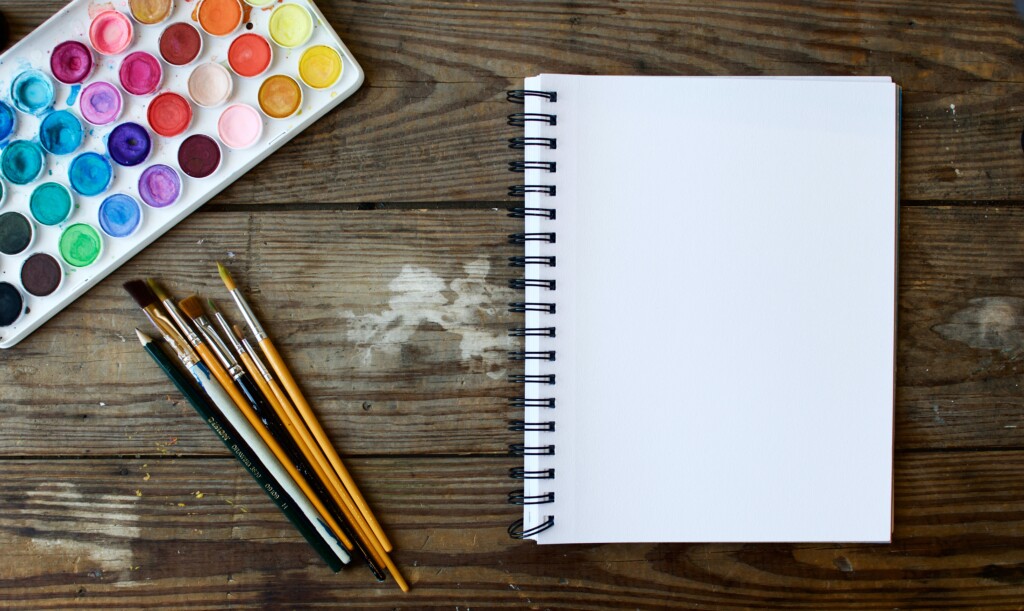
A few tips about working with watercolor:
- Mix more paint than you think you need. Because you are supposed to do it with water.
- Do not over mix the paint.
- Note that watercolors become lighter as they dry.
- Use the right brush in the right size for painting.
- Clean and wash the paint palette and brushes after each painting.
- In order to progress in your work, be sure to dedicate time in the day to practice it.
- Measure progress in your work regularly.
- Because the pigments in each watercolor are different in terms of toxicity, so when using watercolor, do not eat or drink, and keep your brush and hands away from your mouth.

What are the different watercolor techniques?
There are different watercolor techniques that will help both beginners and professionals to give their best. The types of techniques are as follows:
Wet on wet watercolor technique:
This technique is usually used to paint landscapes, simple skies and anything that gives us a smooth effect. In this case, you apply the colors on a wet paper and let the colors sit next to each other.
Wet on dry watercolor technique:
It is possible to achieve more specific, precise and regular shapes using this technique. Most of the watercolors that are in the illustration style use this technique. Therefore, by using a wet brush on a dry surface, you can have more control over your final design. Because the colors are not supposed to mix.
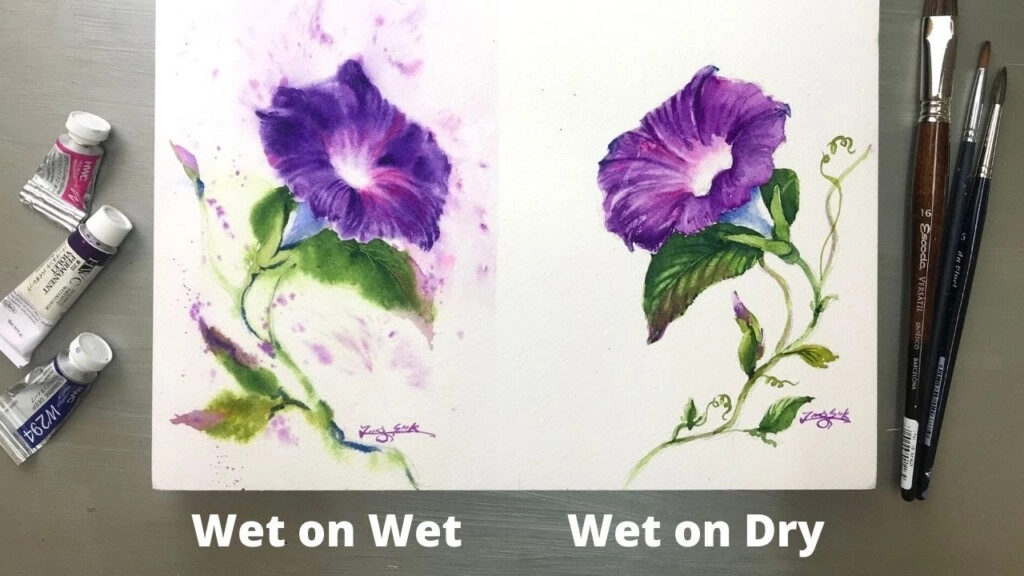
Building up watercolor technique:
Using this technique, you can access different amounts and different shades of that color from just one color. You will end up with a seamless ombre effect. So, in this method, you should gently and gradually add the amount of the main color to the water. So that at the end, your mixture is completely thick.

Creating a gradient watercolor technique:
This technique may be similar to the color building up technique, but in this technique, unlike the previous one, we use two colors instead of one color. All gradients will be created by moving one color to another. So, start with one color and gradually add the second color gently with higher concentrations. Thus, the final color must be the pure concentration of the second color.
Make sure to use colors that are next to each other in the color wheel to create harmony. Otherwise, you will have a muddy gradient. Also, if you need to draw sky or sunset, this can be of good use for you.

Dry brush watercolor technique:
In fact, in this technique, you place an almost dry brush dipped in a small amount of paint onto the surface of the dry paper. In this case, a deposit remains on the ridges of the paper. The best paper for this technique is rough paper.

What are the common mistakes in watercolor?
A. Creating muddy colors
Creating muddy colors is the most common problem that watercolor painters deal with. This happens when you paint on a wet layer. To prevent this from happening, you should add the color when the paper is dry or slightly wet.
B. Loss of luster
Sometimes to add more detail to the painting, the painting may lose its luster. So try not to focus too much on the details to avoid this from happening. And remember that the fewer layers in your painting, the fresher your painting will be.
C. Choosing the wrong size brush
It often happens that people, especially beginners, choose small brushes because they think they can have more mastery and control over the level of detail and stroke size. But you should be careful that if you need to cover a large area and you want to complete this work with a small brush, you need more strokes. As a result, your drawing will be rough. So use a brush of its own size for each section.
D. Rushing the watercolor to dry
Watercolor is one of the painting tools that dries faster, but that doesn’t mean you can add different layers very quickly. Therefore, to use watercolors, you must be patient and give your painting time to dry.

What is the best watercolor paper?
There are different thicknesses and textures of special paper. The best paper is paper made from 100% cotton fabric. Of course, apart from natural papers, there are also synthetic papers that are more popular among artists.
Types of paper for watercolor:
Cold-press paper: The most popular paper is cold-press. This paper is pressed between smooth felt plates. That is why it has a special texture and teeth.
Hot-press paper: Hot-press paper passes between hot rollers to have a smooth surface and texture without teeth. For this reason, this type of paper has less absorption and the pigments appear brighter on it.
Synthetic paper: Actually, this type of paper is made of polypropylene. It also has a very smooth surface that is also resistant to water. Therefore, it does not buckle.
Rough paper: As the name of this paper suggests, this type is not compressed during production, unlike other types. So it should be expected that this paper has prominent teeth. As a result, the pigments sit in the depressions and the texture of the painting becomes grainy.

What is the best watercolor brush?
Because watercolor is a tool that is used with a brush, choosing the right brush is an investment that you can use for a long time with enough care. Watercolor brushes can be made with both artificial and natural hair.
The best type are brushes made with kolinsky otter hair. After that, red otter brushes are suitable. However, today, high-quality artificial brushes have been produced that compete with otter hair brushes and are more durable.
Types of brushes for watercolor:
Flat brush: the tip of these brushes has a straight edge. For this reason, they can be suitable for angled shots. Also, if you need to define precise edges for painting large areas with a uniform color, using this brush is ideal. 1.2 inch, 3.4 inch and 1 inch size is suitable for watercolor painting.
Round brush: The most common and practical brushes for watercolor are round brushes. The tips of these brushes are round and can create wide lines. Choosing numbers 3, 5 and 12 of these brushes are suitable for watercolor.
Wash brush: Well, these brushes are big and flat and can hold a lot of paint. The most useful sizes for watercolors are 1.5 inches and 3 inches.
Mop brush: Mop brush is one of the big and round brushes that can hold a lot of water when wet. So you can use it to mix watercolor colors and wet large areas of paper. Also, the best size is 12.
Liner brush: You can use this brush to create thin and delicate lines like when you want to sign the corner of your painting or add details to it. Because this brush is round and small with a sharp tip. Number 1 is the best brush for watercolor.
Rigger brush: Rigger brushes have very long and thin hairs that all end at one point. With these brushes you can create fine and long lines.
Hake brush: The smooth handle and wide and flat brush of this type does the washing job on a larger scale than the mop brush.

Tips to care for watercolor brushes
- After using each of the brushes, wash them in cold water.
- Never leave brushes in water for a long time.
- Take the excess water from the brushes and shape the brush with your hand.
- Keep the brushes in a jar, with the bristles facing up.
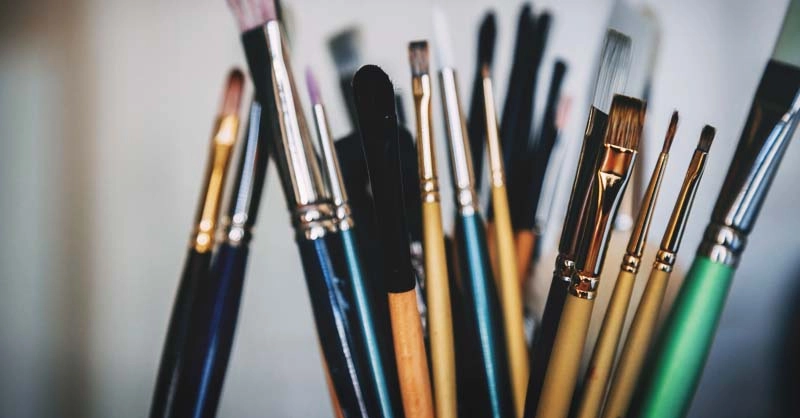
How to mix the colors of the watercolor?
For color mixing, it is better to take another look at the color wheel and color theory. Here is an article I have written before about this. In addition to the color wheel, the combination of colors is also related to color temperature. We all know that half of the color wheel is warm and the other half is cool. But you know that each color itself can be warm or cold.
Here I will say the warm and cold colors of the three main colors, red, yellow and blue:
Warm reds include Naphthol red, cadmium red and Pyrrol scarlet. In contrast, cool reds include permanent carmine, alizarin crimson, and quinacridone magenta.
Also, warm yellows include Indian Yellow, Cadmium Yellow and New Gamboge. And on the other hand, cold yellows include Hansa yellow light and lemon.
Finally, warm blues include Indanthrone blue and ultramarine. And on the contrary, cool blues include cerulean, phthalo blue and Manganese.
Also, from the combination of the three primary colors of the color wheel, neutral colors such as Perylene maroon, quinacridone gold, and Prussian blue are created, which you can use to draw landscapes.

Determining whether a color is warm or cool
To determine the temperature of coolness and warmth of the three main colors, you need to pay attention to whether the red color is more toward the purple color or the orange color. Yellow is more inclined to green or orange and finally blue moves more towards purple or green.
It is almost easier to determine the temperature of red and yellow shades than blue. However, the easiest way to determine whether the color is cold or warm is to add some white paint to the desired color or dilute the desired color with water. Because with the pastel version, it will be easier for you to recognize.

Consider the strength of each color
To mix colors, be sure to consider the strength of each color. Because some colors have more pigments. As a result, that color will be dominant in the color combination.
For example, dark and red colors are strong colors, or ultramarine blue and phthalo. On the contrary, bright colors such as white and yellow are classified as weak colors. So when mixing colors, you can start with light colors first and gradually add dark colors.
Color mixing methods
You can combine colors on a palette to combine them. Because it is easy to clean the color on the palette and if there is an error in the color combination, it can be corrected. Your color palette must be white to show your color combination correctly and realistically.
On the other hand, you can combine the colors on your work surface, staying on the watercolor paper and while working. In this case, so that the colors do not become muddy, it is better to let the bottom layer dry and then apply the next layer. As I said above, in this method, you cannot correct the error in the color combination.
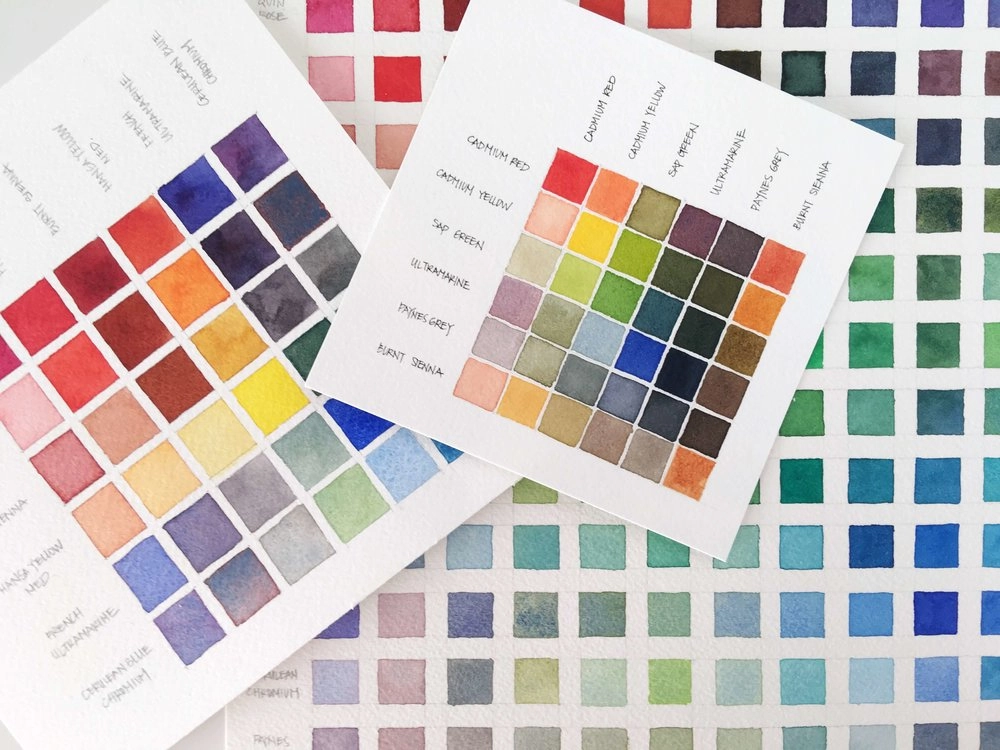
Color combination through color schemes
In fact, using the color schemes of the color wheel is the best step to start painting with watercolors. However, you can combine any color you like.
Monochrome
In this color scheme, you use different shades and tones of the same color. In this way, you can create a calm and harmonious effect.

Analogous
Analogous is a color scheme that uses colors such as blue-green, green and yellow-green that are next to each other in the color wheel. These designs, as they are mostly seen in nature, show a calm and harmonious effect.

Complementary
Colors that are opposite each other on the color wheel create a complementary design. These color designs create excitement and tension in the viewer. So you can use one color as the main color and the second color as an accent.

Traidic
When you use three colors that are at an equal distance from each other in the cycle such as blue-green, red-violet, and yellow-orange, you can have a beautiful and eye-catching design.
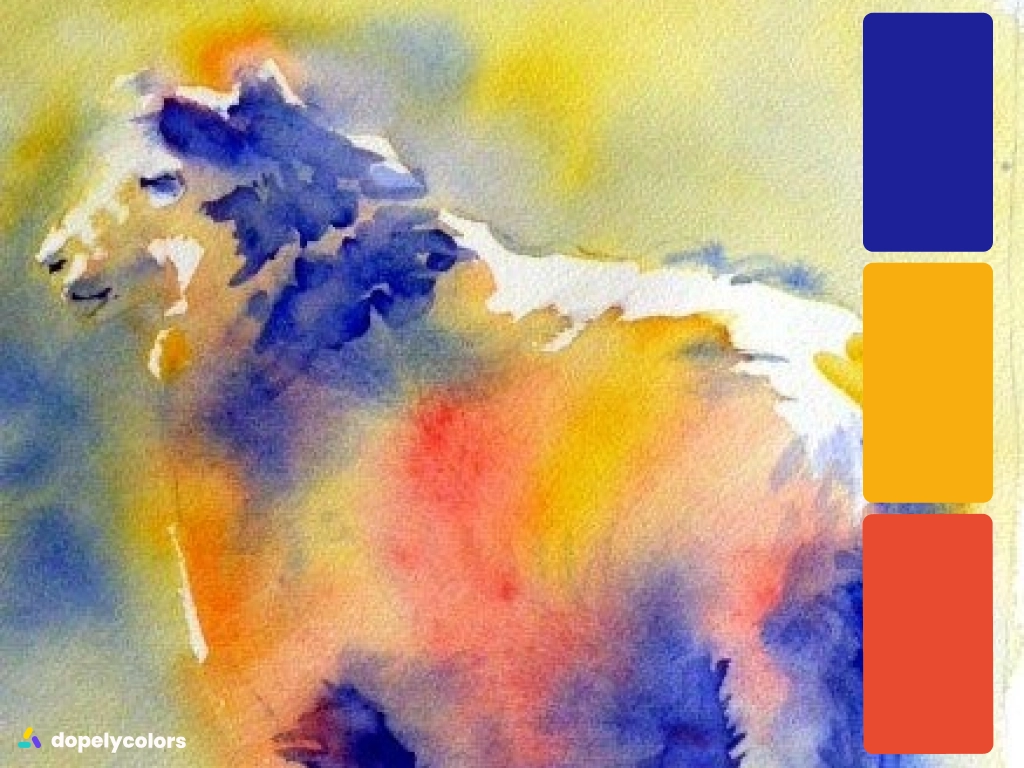
Split Complementary
In this color scheme, colors around the complementary color of a particular color are used and a three-color scheme is created, such as red, blue-green and yellow-green. Such design create excitement.
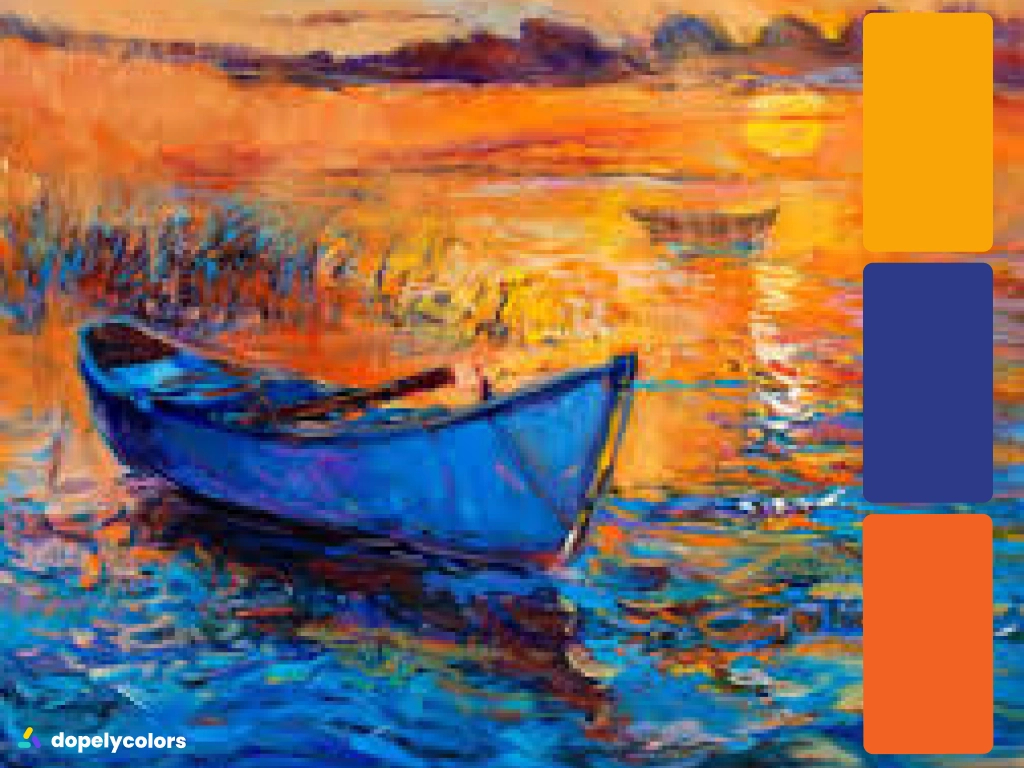
Color palette inspiration of watercolor paintings
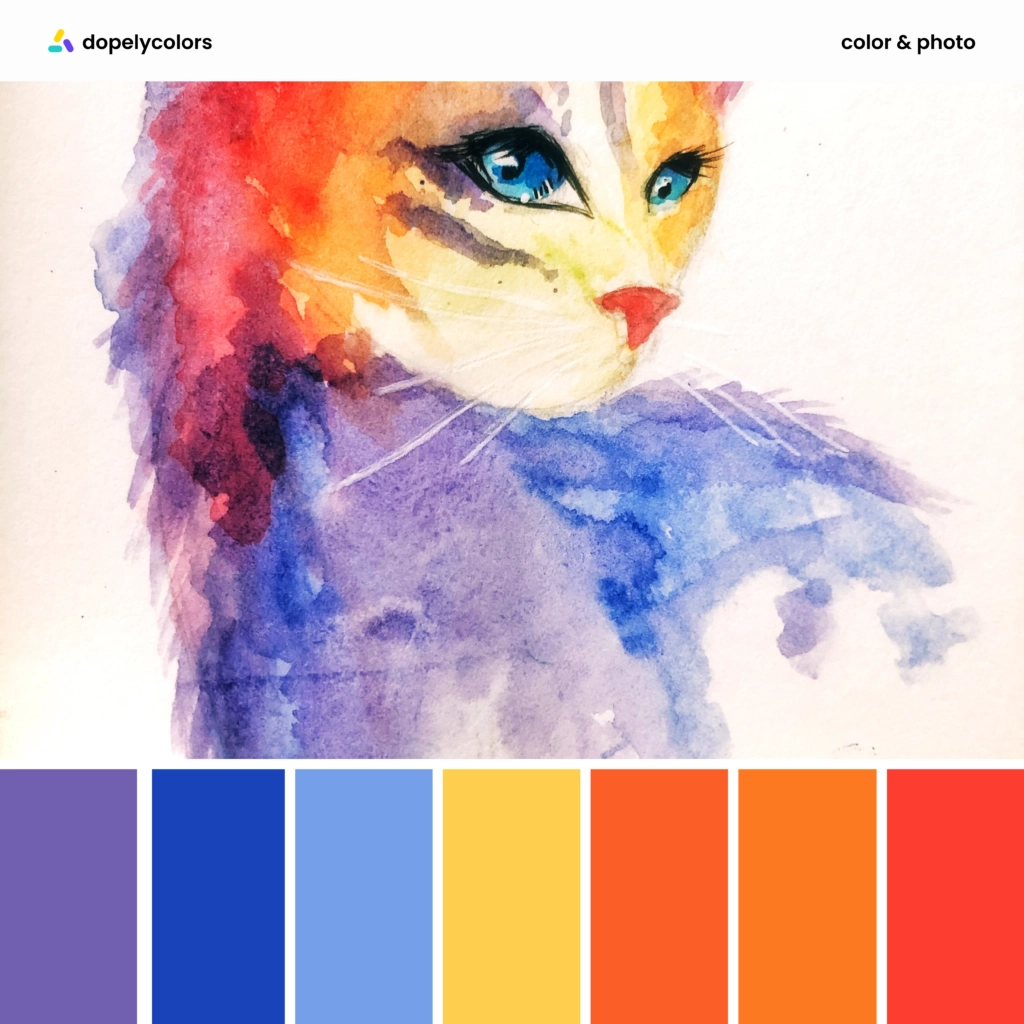




Last words
With the correct use of watercolor techniques and colors, you can create the most beautiful watercolor works. It doesn’t matter if you are a professional or a beginner!
No matter which color you choose to start painting, remember that over time you can add more colors to the previous mix. You can also create new colors, it all depends on you and your creativity.
Now tell me, what colors do you like for watercolor? Have you ever used watercolor as a painting tool?




